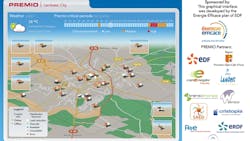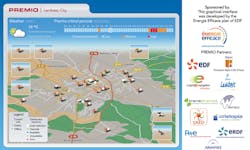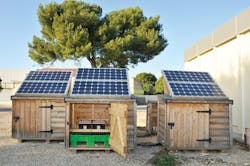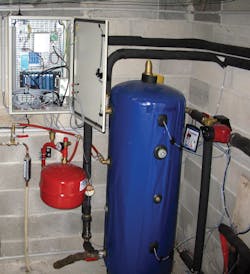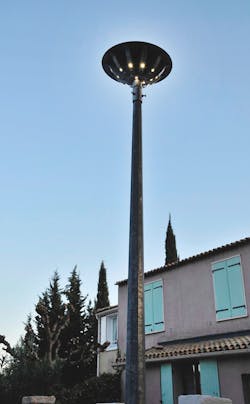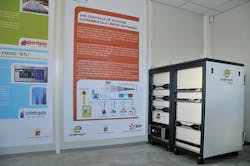France Pilots Virtual Power Plant
Utilities around the world recognize the benefits of demand-side management (DSM) strategies and integrating distributed energy resources into power systems and electrical markets. Initiatives combining the benefits of these DSM programs with the advantages of information and communication technologies are enabling the effective growth of smart grids. An effective way to profit from linking all of these technologies is with a virtual power plant (VPP).
The French smart grid demonstration project Integration and Optimization of Distributed Generation, Demand-Side Management and Renewable Energies (known as PREMIO) is co-funded by the Provence-Alpes-Côte d’Azur (PACA) region. PREMIO integrates distributed energy resources (DERs) into a VPP, develops demand response, distributed generation and storage, and contains all the principal components of future smart grids. Furthermore, PREMIO addresses deficiencies in the reliability of supply in the PACA region of France.
Electricity demand in the PACA region is concentrated on the Mediterranean Coast and accounts for 80% of the total regional power consumption. Local generation capacity is only sufficient to supply less than 50% of the regional demand, thus the shortfall in electrical energy has to be imported from other regions.
A double-circuit 400-kV transmission line supplies the PACA region, and when the regional system is overloaded, the French transmission system operator may have to limit the load transfer through this circuit to prevent power outages. When power shortages occur, the local generating facilities are requested to increase their power output in accordance with their operating capacities. Particularly in the summer, an N-2 contingency is possible on this double-circuit 400-kV line because of forest fires. In this case, a 225-kV transmission line that often has insufficient load-transfer capacity is the only alternative circuit to supply the PACA regional load requirements.
Electricité de France Action Plan
Electricité de France (EDF) launched an action plan, called Energie Efficace, to secure the electricity supply in the PACA region by developing DSM strategies and integrating renewable energies. The objectives of the utility’s plan closely match those of the PREMIO project. EDF is a participant in PREMIO, which is led by Capenergies — an association of companies, research centers and training centers dedicated to low carbon-dioxide emission energy sources: energy efficiency, renewable and nuclear energy — in collaboration with three local and seven regional authorities, two research centers and EDF.
PREMIO was designed to test the control of various DERs in a local territory.
Its objective is to provide participants in the electricity market, or power system operators, the possibility of reducing their electrical consumption or increasing their generation, based on their needs or constraints.
One of the first smart grid projects in France, PREMIO is currently hosted by the city of Lambesc, but some DERs are located in two other nearby cities, Gardanne and Frejus. The PREMIO demonstration project brings lessons from the field to its project partners, enabling different stakeholders to identify potential technologies. They are then in a position to assess the advantages and disadvantages, participate in the development of standards, identify technical or functional gaps, and work with the drivers that will determine the shape and deployment of smart grids.
Additionally, EDF is a member of the Electric Power Research Institute (EPRI) and participates in its smart grid demonstration initiative. EPRI conducts regional demonstrations and supports research focused on smart grids and the integration of DERs. PREMIO is the host site supported by EDF and offers opportunities for research and collaboration, disseminating its findings throughout the international community.
The DER Integrated into PREMIO VPP
The goal of this VPP is to offer day-ahead and day-of (up to 30 minutes before) services for optimal load reduction from the perspective of an upstream operator. Note that PREMIO uses load reduction to denote either a decrease in electrical demand or an increase in generation. The VPP will respond to the needs of an upstream operator by controlling the different DERs connected to a single control unit.
To make an offer to the upstream operator, the control unit receives, or calculates, the individual capacity for the load reduction of each DER. The control unit also receives information from the upstream operator about the time periods when the operator will need more capacity. All this information, represented by a score and a color, converges into the control unit as an offer, optimized according to its critical periods, is then communicated back to the upstream operator. The control unit operator thus transmits the capacity of its portfolio, that is, its aggregated capacity for load reduction. Following the load-reduction request sent by the upstream operator, the control unit dispatches individual requests to downstream DERs by a process of economic optimization, taking into account both the DERs’ operating capacity and the host customers’ comfort constraints.
In theory, PREMIO allows the integration of all types of DERs. Nevertheless, taking into account present environmental restrictions and the partners’ ambitions to generate electricity through low carbon-dioxide emission resources, DERs are limited to controllable loads, renewable distributed generation and storage. Additionally, the DERs participating in PREMIO should be a pre-existing, mature technology compatible with the weather, energy sources, commercial activity and population. Seven DERs were selected:
- Cooling storage: Thermal storage for industrial and tertiary cooling applications — one system, Cristopia Energy Systems
- PAC: Hot-water tanks coupled with heat pumps to provide load shifting in residential homes — six systems, EDF
- Microscope: Domestic electric storage units coupled to photovoltaic panels — 22 systems, EDF
- Optilesteur: Load-shedding modules dedicated to residential and small tertiary buildings — 12 systems, EDF
- Pulssi: Load-shedding boxes for residential homes and apartments — six systems, Watteco
- Public lighting: Adapted light-emitting diode-based public lighting — 10 systems, Watteco
- Solar thermal: Small solar thermal power plant with thermal storage — one system, Sophia Antipolis Energie Devéloppement (SAED).
Lessons Learned
Different domains of knowledge — namely, telecommunications, electrotechnics, mechanics, automation, informatics, sociology, architecture — were necessary for planning and building the PREMIO platform. The project partners brought their own languages and unique understanding of the project specifications along with their own priorities. The use cases developed during the project were useful in defining the scope of the project, harmonizing specifications and common understanding between partners, as well as defining a common language for effective collaboration.
Feedback from the DER installation period shows host customers must be kept informed as much as possible during the installation phase and be associated with the project during the operational phase. Even though the performance of most of the technologies is supposed to be imperceptible by the host customers (load shedding, Optilesteur and Pulssi, for example), they are the closest to the devices and want information about the different steps of the project and the operation of their DER. They also want to understand the purpose of the intervention and be aware when installed devices are operating. This basic information can improve customer acceptance of these new technologies.
The installation phase highlighted the importance of subcontractors and subcontractor training to the PREMIO project. For the most part, the devices used in PREMIO were new to the subcontractors tasked with the installation, and a lengthy learning curve can bring misunderstanding and delay. For example, temperature measurements inside residential homes are needed to guarantee host customer comfort and evaluate the acceptability of the devices.
It is important for temperature sensors to be placed in an area with a representative of the host-customer comfort; however, in some cases, because of ease of installation or a host-customer suggestion, the subcontractor installed the temperature sensor in an unsuitable location. Moreover, subcontractors are the point of contact with the host-customer and bring their field experience to the project partners. From the perspective of a smart grid deployment rollout, subcontractor training should be a priority.
PREMIO Rollout Program
PREMIO began its operation during the winter of 2010-2011. This period was mostly dedicated to testing, establishing improved devices, learning how the new DER technologies behave and identifying potential problems. It is important to note the PREMIO project enabled a qualitative more than a quantitative assessment of the results, mainly because of the low number of DER units installed.
DERs responded to requests sent by the control unit, and load reductions issued from direct control were effective. Control unit optimization and request dispatch processes were validated. The variation between power requested and effective load reduction (often less than requested) was, in most cases, because of underestimation or overestimation of load reduction capacity. Load-reduction accuracy varies depending on the DER considered.
Because of the high level of uncertainty in the residential sector’s electrical demand, accurate forecasting for individual capacity seems to be difficult. Research in this field is ongoing and a certain level of aggregation to estimate capacity for this type of DER should be considered.
Microscope technology — 4.8-kWh batteries and photovoltaic panels to store and provide electricity to the grid — was the first DER to be connected in the PREMIO platform and be fully operational. This demonstrated microscope technology’s ease of integration into a smart grid, compared to other DERs. This technology can charge and discharge electric power — on average, 700 W per system, but many systems are installed per site — according to the needs of the electrical power system, such as increased generation or voltage regulation.
For example, initial feedback from the field showed the impact of several factors, including battery damage from deep discharge, thermal losses from overloads and variations in the system efficiency of different types of batteries. The use of open lead batteries entails frequent maintenance operations (every two to three months), but replacing them with sealed lead batteries reduced maintenance costs but introduced challenges in regulation, such as taking into account battery temperature. In addition, microscope technology’s range of power and energy could be increased by using 10-kWh batteries able to deliver 2 kW to 3 kW. These batteries are the subject of future development of this technology.
The Future
While some DERs operated during the summer of 2011, all of the DERs have been running since the 2011-2012 winter, and feedback has been obtained from each of them. Improvement in service reliability, DER regulation and deeper analysis of the platform have been achieved. Lessons learned from PREMIO are now being integrated in wider smart grid demonstration and pilot projects in France. In addition, modeling and simulation of PREMIO gives an indication of the impact of the PREMIO platform on a larger scale by considering several districts.
Carolina Tranchita ([email protected]) received a Ph.D. degree in electrical engineering from Grenoble Institute of Technology in France and a MSE degree from Los Andes University in Colombia. Currently, she is a researcher and project manager at Electricité de France/EIFER and participates in the PREMIO project as technical director. Tranchita’s research interests include smart grids and demand-side management strategies in the planning and operation of power systems and the relationship with cities’ and territories’ development
John J. Simmins ([email protected]) is a technical executive for the Electric Power Research Institute. He has bachelor’s and Ph.D. degrees in ceramic science from Alfred University and develops robust system architecture for the EPRIsmart grid demonstration projects. Simmins also brings thought leadership in the area of integrating diverse applications such as advanced meter infrastructure, meter data management systems, distribution management systems, customer information systems, geospatial information systems and outage management systems.
